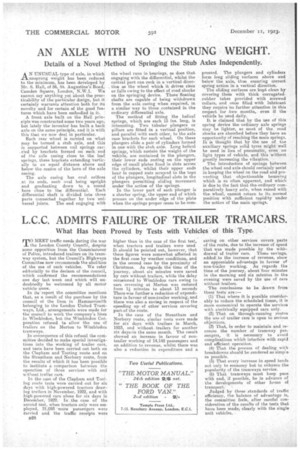L.C.C. ADMITS FAILURE OF TRAILER TRAMCARS.
Page 12

If you've noticed an error in this article please click here to report it so we can fix it.
What Has been Proved by Tests with Vehicles of this Type.
TO MEET traffic needs during the wJ. the London County Council, despi some opposition from the Commissione of Police, introduced trailers on its tra way system, but the Council's Highway Committee now recommends the abolitio of the use of suchvehicles: We refe editorially, to the decison of the council, which confirmed the recommendation one day last week and which will u doubtedly be welcomed by all mote
vehicle users.
In its' report the committee mention that, as a result of the purchase by th council ot the lines in Hammersmi., belonging to the London United Tra ways, Ltd., arrangements were made f the council to work the company's lin in Wimbledon, but the Wimbledon Co poration refused to allow the use cf trailers on the Merton to Wimbiedols tramways.
In consequence of this refusal the co mittee decided to make special investig tions into the working of trailer car, and tests have been carried out both 0L1 the Clapham and Tooting route and o the Streatham and -Norloury route, fro the results of which it has been possib e to institute a comparison between the operation of those services with an without trailer ears.
In the case of the Clapham and Too lug route tests were carried out for six days with high-powered tractors dra tog trailers in November, 1922, and. with high-powered cars alone for six days ln December, 1922. In the case of tile second teat, when tractors only were e ployed, 21,093 -mere passengers we e carried and the traffic receipts we
higher than in the case of the first test, when tractors and trailers were used It should be pointed out, however, that these figures were somewhat affected in the first case by weather conditions, and in the second case by the proximity of Christmas. As regards the time of the journey, about six minutes were saved by cars without trailers, while the delay occasioned to Wimbledon cars owing to cars reversing at Merton was reduced from 1 minutes to about 15 seconds There was further a redaction of expenditure in favour of non-trailer working, and there was also a Saving in respect of the speeding up of other services covering part,of the route.
In the case of the Streatham and Norbury route, similar tests were made for six days with trailers in March, 1923, and without .trailers for another six daysiin the same month. The result showed an increase in favour of non trailer working of 14,148 passengers and an addition to revenue, whilst there was also a reduction in expenditure and a
saving on other services covers pasta of the route, due to the increase of speed that was made possible by the withdrawal of trailer cars. These savings, added .to the increase of revenue, show an appreciable advantage in favour of non-trailer working. As regards the time of the journey, about four minutes in the morning and six minutes in the evening were saved by the use of cars without trailers.
The conclusions to be drawn from the.se tests are:—
(1) That where it is possible considerably to reduce the scheduled times, it is more economical to operate the services with electrically equipped cars only. (2) That on through-running routes the use of trailer cars is open to serious objections.
(3) That, in order to maintain andailcrease the number of tramway passengers, it is necessary to avoid complications which interfere with rapid and efficient operation. (4) That the process of dealing with breakdowns should be rendered as simple as possible. (5) That every increase in speed tends not only to economy but to enhance the popularity of the tramways service. (6) That 'tramways must keep pace with and, if possible, be in advance of the developments of other forms of transport; Judged by these standards of traffic efficiency, the balance of advantage is, the committee feels, after careful consideration of the results of the tests that have been made, clearly with the single unit vehicles.
































